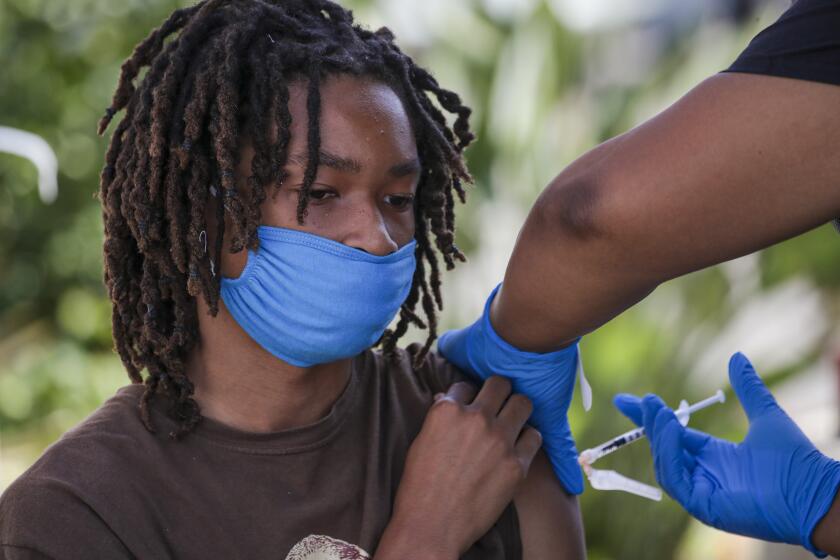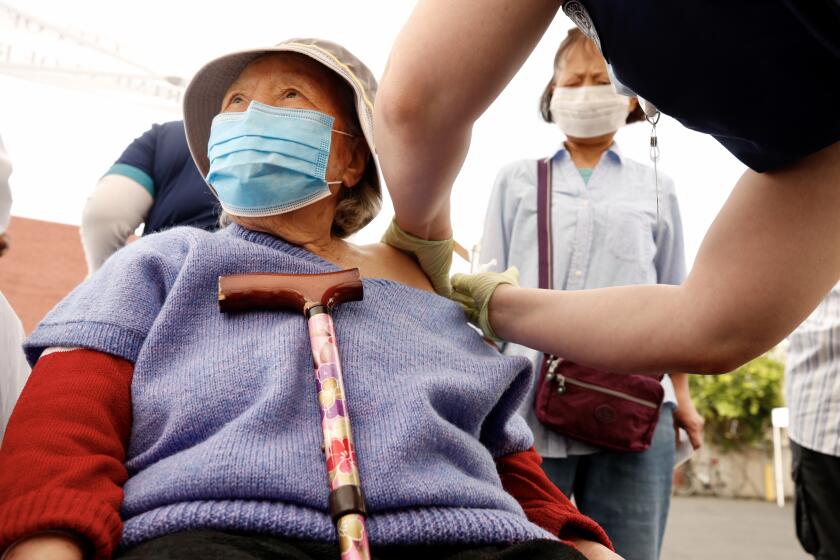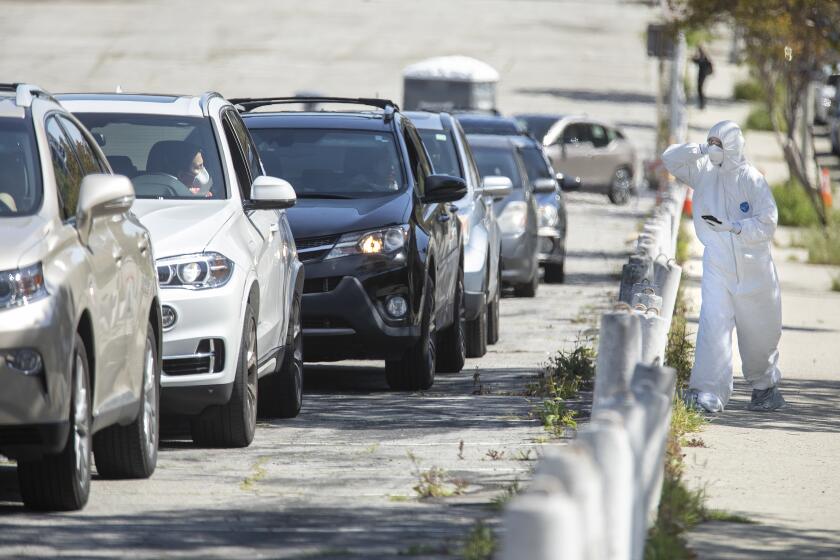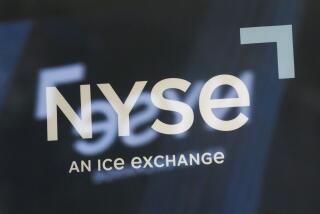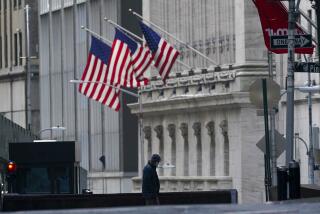Investors dump stocks, buy bonds as virus fears flare again
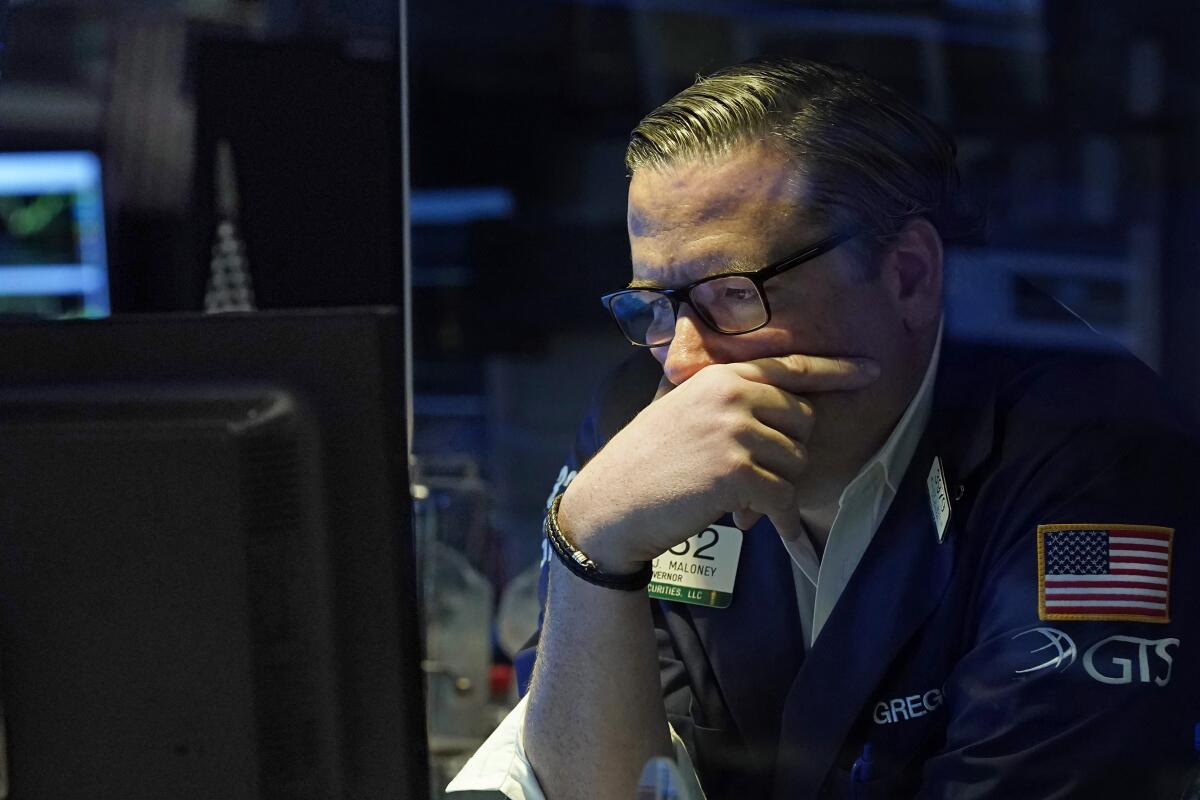
- Share via
NEW YORK — Resurgent pandemic worries knocked stocks lower from Wall Street to Sydney on Monday, fueled by fears that a faster-spreading variant of the coronavirus may upend the economy’s strong recovery.
The Standard & Poor’s 500 index fell 68.67 points, or 1.6%, to 4,258.49 after setting a record just a week earlier. In another sign of worry, the yield on the 10-year Treasury touched its lowest level in five months as investors scrambled for safer places to put their money.
The Dow Jones industrial average slumped 725.81 points, or 2.1%, to 33,962.04, while the Nasdaq composite lost 152.25 points, or 1.1%, to 14,274.98.
Airlines and stocks of other companies that would get hurt the most by potential COVID-19 restrictions were taking some of the heaviest losses, similar to the early days of the pandemic in February and March 2020. United Airlines lost 5.5%, mall owner Simon Property Group fell 5.9%, and cruise operator Carnival gave up 5.7%.
The selling also circled the world, with several European markets sinking roughly 2.5% and Asian indexes down a bit less. The price of benchmark U.S. crude, meanwhile, sank more than 7% after OPEC and allied nations agreed on Sunday to eventually allow higher oil production this year.
Los Angeles County is now recording more than 10,000 coronavirus cases a week — a pace not seen since March.
Increased worries about the virus may seem strange to people in parts of the world where masks are coming off thanks to COVID-19 vaccinations. But the World Health Organization says cases and deaths are climbing globally after a period of decline, spurred by the highly contagious Delta variant. And given how tightly connected the global economy is, a hit anywhere can quickly affect businesses on the other side of the world.
Experts are saying Indonesia has become a new epicenter for the pandemic as outbreaks worsen across Southeast Asia. Meanwhile, some athletes have tested positive for COVID at Tokyo’s Olympic Village, with the Games due to open Friday.
Even in the United States, where the vaccination rate is generally higher, people in Los Angeles County once again must wear masks indoors regardless of whether they’re vaccinated after surges in cases, hospitalizations and deaths.
Across the country, the daily number of COVID cases has soared by nearly 20,000 over the last two weeks to about 32,000. The vaccine campaign has hit a wall, with the average number of daily inoculations sinking to the lowest levels since January. Cases are on the rise in all 50 states.
Localized coronavirus surges are starting to affect heavily unvaccinated communities in places such as Missouri and Arkansas, where hospitals are running out of space again. Almost all of the hospitalized COVID patients are unvaccinated. More than 68% of the U.S. adult population has received at least one dose of vaccine and 59% are fully vaccinated. And about a dozen states have yet to vaccinate 40% of their population.
That’s why markets are concerned, even though reports show the economy is still recovering at a fantastically high rate and the general expectation is for it to deliver continued growth. Any worsening of virus trends threatens the high prices that stocks have achieved on expectations the economy will fulfill those lofty forecasts.
Financial markets have been showing signs of increased concerns for a while, but the U.S. stock market had remained largely resilient. The S&P 500 has had just two down weeks in the last eight, and the last time it had even a 5% pullback from a record high was in October.
State unemployment held steady in June at 7.7%, and the pace of job gains lost steam as workers take jobs more slowly than in previous recession periods.
Several analysts pointed to that backdrop of high prices and very calm movements for weeks while dissecting Monday’s drop.
“It’s a bit of an overreaction, but when you have a market that’s at record highs, that’s had the kind of run we’ve had, with virtually no pullback, it becomes extremely vulnerable to any sort of bad news,” said Randy Frederick, vice president of trading and derivatives at Charles Schwab. “It was just a matter of what that tipping point was, and it seems we finally reached that this morning” with worries about the Delta variant.
He and other analysts are optimistic stocks can rebound quickly. Investors have been trained recently to see every dip in stocks as merely an opportunity to buy low. Plus, the general expectation is still for the economy to continue growing.
Barry Bannister, chief equity strategist at Stifel, was more pessimistic. He said the stock market may be in the early stages of a drop of as much as 10% after its big run higher. The S&P 500 nearly doubled after hitting its bottom in March 2020.
“The valuations, they just got too frothy,” he said. “There was just so much optimism out there.”
L.A. County officials say with COVID-19 cases and hospitalizations growing, they hope reinstituting masking as a social norm will help reduce disease transmission.
The bond market has been louder and more persistent in its warnings. The yield on the 10-year Treasury tends to move with expectations for economic growth and for inflation, and it has been sinking since late March, when it was at roughly 1.75%. It fell to 1.19% on Monday from 1.29% late Friday.
Analysts and professional investors say a long list of reasons is potentially behind the sharp moves in the bond market, which is seen as more rational and sober than the stock market. But at the heart is the risk the economy may be set to slow sharply from its current, extremely high growth.
Besides the new variants of the coronavirus, other risks to the economy include fading pandemic relief efforts from the U.S. government and a Federal Reserve that looks set to begin paring back its assistance for markets later this year.
Monday’s selling pressure was widespread, with nearly 90% of the stocks in the S&P 500 lower. Even Big Tech stocks fell, with Apple down 2.7% and Microsoft 1.3% lower. Such stocks seemed nearly immune to virus fears during earlier downturns, rising on expectations they’ll continue growing almost regardless of the economy’s strength.
Federal regulators revoked the authorization of a COVID-19 test given to millions of people across the country, including hundreds of thousands at Dodger Stadium.
Across the S&P 500, analysts are forecasting profit growth of nearly 70% for the second quarter from a year earlier. That would be the strongest growth since 2009, when the economy was climbing out of the Great Recession.
But just like worries are rising that the economy’s growth has already peaked, analysts are trying to predict how much growth rates will slow in upcoming quarters and years for corporate profits.
Associated Press business writer Yuri Kageyama contributed to this report.
More to Read
Inside the business of entertainment
The Wide Shot brings you news, analysis and insights on everything from streaming wars to production — and what it all means for the future.
You may occasionally receive promotional content from the Los Angeles Times.
